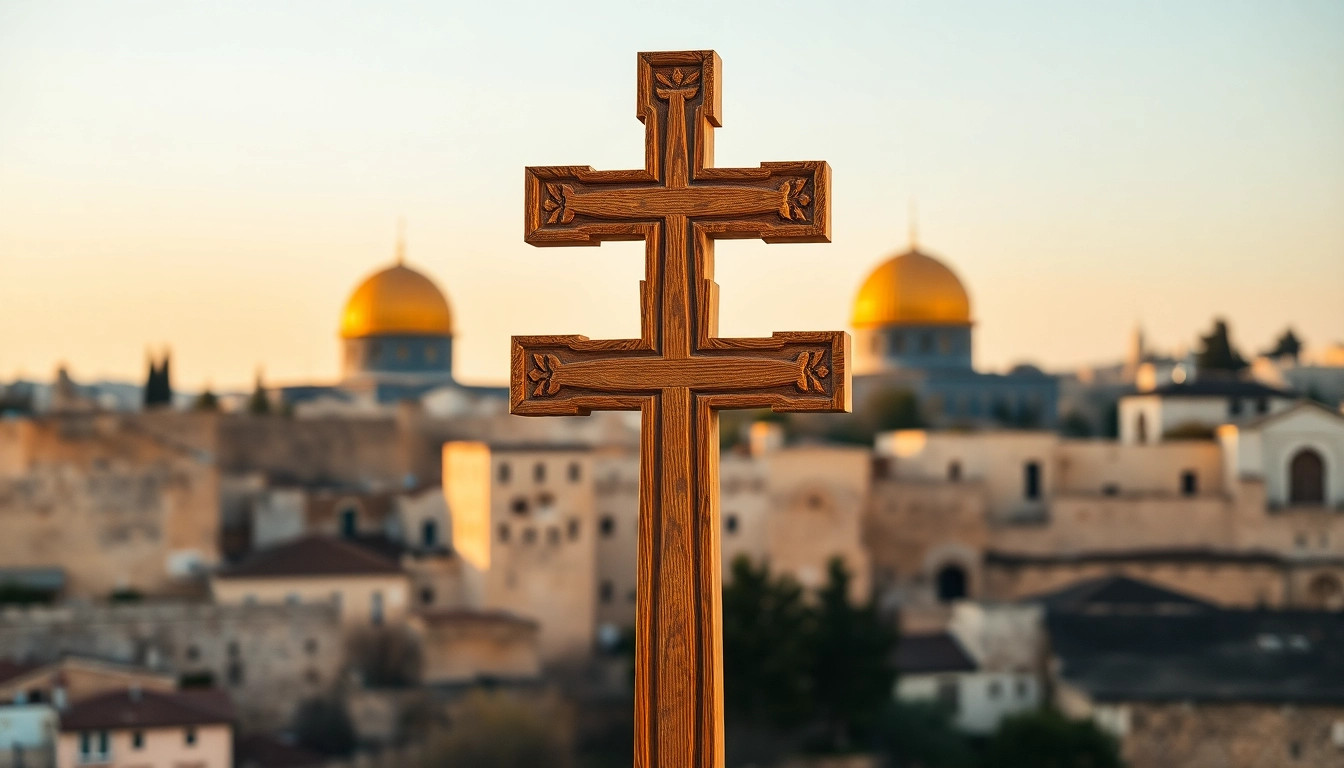Understanding the Jerusalem Cross
What is the Jerusalem Cross?
The Jerusalem cross, also known as the “Crusader’s Cross,” is a distinctive heraldic and Christian cross variant. It consists of a large central cross potent, known for its arms that broaden at the ends, surrounded by four smaller Greek crosses that occupy the quadrants of the larger central cross. This intricate design is not simply ornamental; it carries rich layers of symbolism and historical significance. Often associated with the Kingdom of Jerusalem during the Crusades, the Jerusalem cross is not merely a relic but a representation of iconography that encapsulates faith, history, and regional identity.
The Symbolism of Jerusalem Crosses
Each component of the Jerusalem cross holds significant meaning. The large cross symbolizes the crucifixion of Jesus Christ, representing his sacrifice for mankind’s sins. The four smaller crosses are widely interpreted to signify the Four Evangelists—Matthew, Mark, Luke, and John—who spread the Christian gospel across the world. Alternatively, they are seen as symbols of the four cardinal directions, representing the message of Christ’s teachings spreading to the ends of the earth. This potent blend of theological and geographical symbolism renders the Jerusalem cross a powerful emblem of Christian faith and mission.
Historical Significance of the Jerusalem Cross
Historically, the Jerusalem cross has deep roots that trace back to the medieval period. It emerged prominently during the Crusades, when the Latin Kingdom of Jerusalem was established in 1099. The symbol became a badge of the Crusaders, who viewed it as a representation of their mission to reclaim the Holy City of Jerusalem from Muslim rule. Over the centuries, it evolved into a symbol of Christian heritage in the region, influencing art, architecture, and religious practices. Today, it is still revered as a symbol by many Christian denominations, reflecting the ongoing legacy of faith that it embodies.
Elements of the Jerusalem Cross
The Central Cross: Meaning and Importance
The central cross is the focal point of the Jerusalem cross, commanding attention and reverence. Its design, which features a potent style, signifies strength and stability. It embodies the crucifixion and resurrection of Jesus, symbolizing triumph over death and the promise of eternal life. This central element serves as a powerful reminder for believers of Christ’s ultimate sacrifice and serves as a foundation upon which the smaller crosses build their meanings.
The Four Smaller Crosses Explained
Flanking the central cross are the four smaller Greek crosses, each signifying crucial aspects of Christian theology. Each cross not only represents one of the Evangelists but also highlights the universal reach of the Christian message. By depicting Christ’s teachings as traveling in all four directions, the Jerusalem cross illustrates the notion of faith transcending geographical and cultural boundaries. This design etches into the mind the idea that Christianity is not confined to one space but is a global narrative.
Common Materials Used in Jerusalem Crosses
Authentic Jerusalem crosses are often crafted from various materials, each adding to the cross’s significance. The most revered are made from olive wood, a symbol of peace, which ties back to the regions surrounding Jerusalem. Other materials include silver, gold, and stone. Artists utilize these materials not only for aesthetic purposes but also for their spiritual symbolism—each material tells a story and connects the physical craftsmanship to the sacred discussion surrounding the Jerusalem cross.
Where to Find Authentic Jerusalem Crosses
Local Artisans and Craftsmanship
For those seeking authentic Jerusalem crosses, local artisans in the Holy Land provide some of the most genuine pieces. These artisans, often descended from generations of craftsmen, imbue their work with deep cultural significance and personal touch. Traveling through the markets of Jerusalem, one can discover a variety of designs, each telling a unique story through its craftsmanship. This dialogue between tradition and art fosters a deep appreciation for the crosses that extend beyond their physical forms.
Leading Online Boutiques for Jerusalem Crosses
In addition to local artisans, numerous online retailers specialize in authentic Jerusalem crosses. These boutiques often offer detailed descriptions of the craftsmanship and materials used, allowing buyers to make informed decisions. Many trusted websites provide guarantees of authenticity and ethical sourcing of materials, ensuring that your purchase is not just meaningful but also responsible. For more information and options, explore Jerusalem crosses and discover a range of unique pieces tailored to diverse tastes and budgets.
Tips for Identifying Genuine Jerusalem Cross Products
When searching for authentic Jerusalem crosses, certain tips can help in identifying quality products. Look for clear markers of craftsmanship: genuine pieces will demonstrate detailed workmanship and will often be accompanied by documentation of authenticity. Attention should also be paid to the materials used—olive wood should feel natural and have distinct markings, while metal crosses should bear signs of high-quality finishing. Furthermore, reputable sellers often provide insights into the history and cultural significance of the items, enhancing the authenticity of the purchase.
Cultural and Religious Perspectives
The Jerusalem Cross in Christianity
In Christian circles, the Jerusalem cross holds diverse meanings, extending well beyond its historical roots. To many Christians, it represents the faith’s enduring message of hope and salvation. It serves as a reminder of the missionary work cited in the New Testament, encouraging believers to spread the gospel. The cross is also adopted by various denominations, where it often finds a place in liturgical items, representing the communal identity of believers in Christ.
Contemporary Use and Popularity of Jerusalem Crosses
Today, the popularity of the Jerusalem cross continues to be robust among Christians. It is frequently used in jewelry, decorative art, and ecclesiastical items. The cross resonates with individuals not only as a religious symbol but also as a personal reflection of faith and identity. Many wear the Jerusalem cross as a badge of their beliefs, finding comfort and connection to its rich history. Its image has transcended time, adapting to modern aesthetics while maintaining its profound spiritual significance.
Controversies and Misunderstandings
Despite its positive connotations, the Jerusalem cross has not been free from controversies. Some interpretations link it to nationalist and militaristic movements, contributing to misunderstandings about its true meaning. It is crucial to navigate these complexities with care, focusing on the symbol’s original intent as a representation of faith. This involves engaging with its theological underpinnings and honoring the context in which it developed, ensuring that the cross remains a tool for unity rather than division.
Caring for Your Jerusalem Cross
Cleaning and Maintenance Tips
Caring for your Jerusalem cross is essential to preserve its beauty and integrity. Depending on the material, various cleaning methods can be employed. For wooden crosses, a gentle wipe with a soft, dry cloth may suffice, while metal crosses can often be polished with a suitable metal polish. Avoid harsh chemicals that could damage the finish or meaning of the cross, and always check for any specific care instructions from the artist or retailer.
Storing and Displaying Your Jerusalem Cross
When it comes to storing your Jerusalem cross, it’s essential to prevent exposure to extreme temperatures or direct sunlight, which could cause damage. Ideally, display your cross in a safe location where it is protected and can be appreciated. For those who choose to incorporate it into home decor, consider placing it with other spiritual items to create a cohesive and respectful display that honors its significance.
The Importance of Respecting Sacred Symbols
Respecting the Jerusalem cross necessitates an understanding of its spiritual and historical context. As a sacred symbol of faith, it deserves reverence. This includes recognizing its significance in the lives of those who possess it and acknowledging the cultural history it represents. Engaging with the cross through educational avenues can enhance appreciation and promote respect, ensuring it remains a symbol of love, faith, and connection for generations to come.



